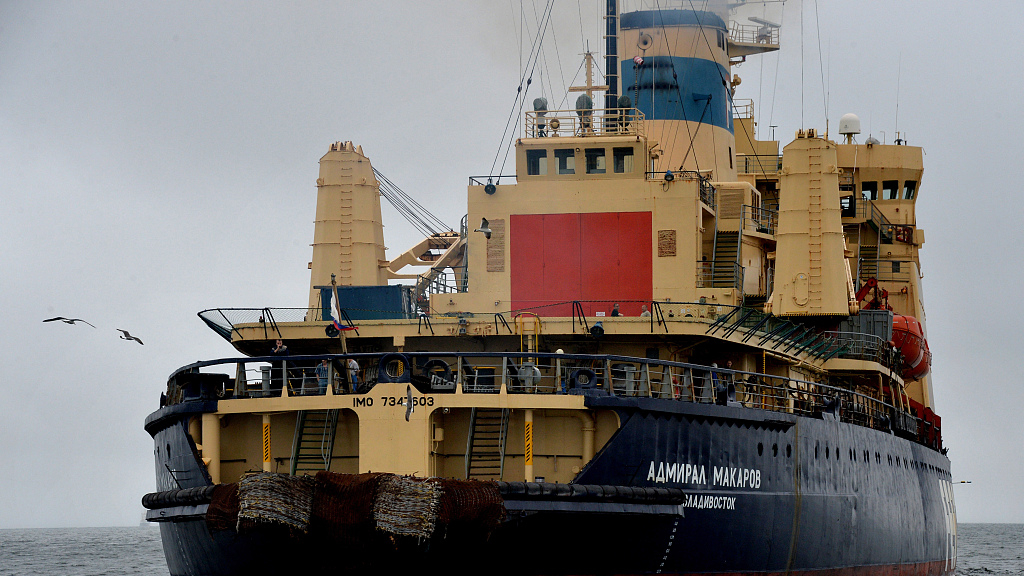
The icebreaker Admiral Makarov in the Eastern Bosphorus strait departing for the summer shipping season on the Northern Sea Route (NSR) in the eastern part of the Arctic. /VCG Photo
The icebreaker Admiral Makarov in the Eastern Bosphorus strait departing for the summer shipping season on the Northern Sea Route (NSR) in the eastern part of the Arctic. /VCG Photo
Editor's Note: Vladimir Petrovskiy is a senior research fellow at the Far East Institute of Russian Academy of Sciences. The article reflects the author's opinions, and not necessarily the views of CGTN.
Russia and China are becoming closer strategic partners, and the Arctic is gradually becoming an area where the two sides can potentially carry out their long-term cooperation.
In the context of China's Belt and Road Initiative (BRI), the Northern Sea Route (NSR) occupies a special place. "The Silk Road reached the very North. We will connect it with the Northern Sea Route, and it will be what we need," said Russian President Vladimir Putin.
This cooperation can become an important direction in the framework of combining the BRI and the Eurasian Economic Union (EAEU).
Russia is considering the possibility of connecting the NSR and the China's "Maritime Silk Road," thereby creating a global and competitive route linking Northeast, East and Southeast Asia with Europe. Such a large-scale project implies close cooperation of Eurasian countries in increasing transit traffic, the construction of port terminals, and logistics centers.
On the one hand, the NSR is already a historically established route: In Soviet times, the bulk of the infrastructure, a powerful icebreaking fleet, and shipping support systems were created. On the other hand, in order to turn the NSR into a high-tech and competitive route of international importance, a complete reconstruction and modernization, and in some cases new construction, is necessary.
China considers the Arctic a shorter and safer route connecting the Chinese mainland with Europe. The Northern Sea Route can become an important strategic complement to the BRI, which combines the Silk Road Economic Belt (through Central Asia to Europe) and the 21st Century Maritime Silk Road (through the South China Sea to the south Pacific Ocean and Europe).
China's white paper on its Arctic policy states that the BRI should provide opportunities for parties interested in creating the Arctic Silk Road, sustainable economic and social development of the Arctic.

Zhang Jianhua, General Manager of China National Petroleum Corporation (CNPC), during the official welcoming of two LNG carriers of Yamal LNG project at Jiangsu Rudong port, China. /VCG Photo
Zhang Jianhua, General Manager of China National Petroleum Corporation (CNPC), during the official welcoming of two LNG carriers of Yamal LNG project at Jiangsu Rudong port, China. /VCG Photo
The Chinese vision of the Ice Silk Road involves the development of scientific, trade and economic cooperation with all Arctic countries in different directions.
However, while developing cooperation with various Arctic countries on joint research and development of the Arctic, China is giving priority to Russia.
According to experts, in the foreseeable future, the main stimulus for the development of the "Ice Road" in this part of the Arctic will be economic projects in the North of Russia.
The main regional project, whose fate is closely connected with the development of the NSR, is the development of the fuel and energy wealth of the Yamal Peninsula.
The Yamal LNG project is of key importance for the route, and in particular, the port of Sabetta laid in its framework – the window of Yamal into the open world.
In April 2019, at the second Belt and Road Forum, it was announced that China National Petroleum Corporation (CNPC) was buying a 10 percent stake in the Arctic LNG-2 project from Novatek.
As a result, the NSR is the most affordable option for China to organize the Arctic transport corridor. For China, it is preferable, since Moscow, like Beijing, seeks to pursue an independent policy in the Arctic and has demonstrated its willingness to invest heavily in the region.
In parallel with the development of ports, navigation and communication systems, Russia is increasing its recourse extraction in the Arctic, primarily oil and natural gas.
The goal is to make the NSR safe and profitable for shippers and attractive both in terms of service quality and price. In particular, a fee for icebreakers should be competitive and justified. In this regard, it should be noted that the issue of fees levied on foreign (including Chinese) shipping companies for using the NSR is a problematic issue that concerns China.
However, unlike other players protesting against such practices (U.S., European Union, Japan), China is ready to work out a consensus with Russia on this issue.
In Russia, they understand that the level of services provided by the domestic icebreaker operator, as well as the NSR administration, should constantly be improved and become as attractive as possible for foreign shipping companies.
These and other problems of Russian-Chinese cooperation in the Arctic will undoubtedly be resolved by the joint efforts of the two countries. Working groups have been created between the relevant departments of the two countries. Negotiations are underway on a memorandum of cooperation between Russia and China in developing the Arctic, which will create the institutional basis for further development and cooperation in this area.
(If you want to contribute and have specific expertise, please contact us at opinions@cgtn.com.)